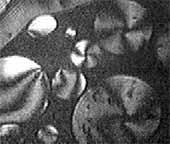From 1984 through 1998 we studied properties of monolayers at the air-water interface using a variety of optical techniques. Much of the interest in monolayers stems from their current and potential technological applications and from their relevance to biophysical problems. In addition, monolayers provide good models for studying two-dimensional physics. For instance, monolayers display a rich variety of phases and phase transitions as a function of temperature, area and surface pressure. Using a heterodyne light scattering technique developed in our laboratory, we studied the effect that monolayers have on the propogation and damping of capillary waves. In particular, we have studied the way in which the monolayer morphology affects the capillary wave damping in phase coexistence regions. In addition, we built a Brewster angle microscope which allowed us to image the morphology of the monolayer in phase coexistence regions (see picture), as well as to gain information about the tilt structures of the molecules in condensed monolayer phases. We also investigated monolayers of a liquid crystal molecule. One of the interesting properties of these monolayers is that they form a two-dimensional smectic C phase -- i.e. a phase in which there is liquid-like positional order, but long range order in the orientation of the molecules. In this phase there are thermally induced fluctuations in the orientation of the molecules, which is visible as a "flicker" in the Brewster angle microscope pictures. We studied these fluctuations as well as the tilt and azimuthal orientation of the molecules within monolayer domains.
Light scattering from liquid interfaces,
at
Physics Colloquium, University of Lowell (Lowell, MA),
Saturday, October 1, 1988
 Single layers of molecules find important applications in coatings, detergents, and in the pharmaceutical industry. In addition, monolayers serve as a model for membranes in biological systems.
Single layers of molecules find important applications in coatings, detergents, and in the pharmaceutical industry. In addition, monolayers serve as a model for membranes in biological systems.